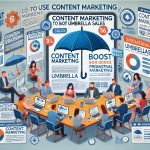The umbrella market is one that is deeply intertwined with the weather patterns of different regions. Weather conditions directly influence when and how umbrellas are purchased, with sales often surging during periods of rain, storms, or intense sun. Understanding these seasonal fluctuations and capitalizing on the ever-changing weather patterns is essential for brands and manufacturers looking to maximize their umbrella sales. By aligning product offerings with specific seasonal demands, understanding regional climate differences, and using strategic marketing techniques, umbrella brands can optimize their sales year-round.
The Role of Weather in Umbrella Sales
Weather conditions play a critical role in determining when umbrellas are most in demand. The presence of rain or intense sun can prompt consumers to purchase umbrellas as a protective measure. Understanding the seasonality of umbrella sales is essential for businesses, as it allows for better inventory management, timely marketing strategies, and product launches that match consumer needs.
The Impact of Rainy Seasons
Rain is, without a doubt, the most obvious weather condition that influences umbrella sales. When storms or heavy rainstorms occur, there is typically an immediate surge in demand for umbrellas, especially in regions with regular rainy seasons. However, the intensity and duration of the rainy season vary across different regions, which means that umbrella manufacturers must pay close attention to local weather patterns to adjust their offerings.
Increased Demand During Wet Seasons
In regions with heavy rainfall, the demand for umbrellas peaks during the wet season, and it is essential for manufacturers to align their production cycles with these periods. For instance, the monsoon season in Asia or the rainy season in the UK or the Pacific Northwest of the United States drives high umbrella sales. During these periods, consumers tend to look for durable, high-performance umbrellas capable of withstanding gusty winds and heavy rainfall.
- Windproof and Durable Designs: During rainy seasons, consumers prioritize durability in their umbrellas. Wind-resistant or windproof umbrellas with reinforced frames and vented canopies become highly sought after. These umbrellas are designed to stand up to gusty winds and heavy downpours, making them particularly appealing during stormy weather.
- Compact and Portable Umbrellas: For those who may need to carry an umbrella during unpredictable rain showers, compact and foldable designs are popular. These portable umbrellas are easy to carry around and can be conveniently stored in bags or backpacks when not in use.
Marketing Strategies for Rainy Seasons
To capitalize on rainy season sales, brands can focus their marketing efforts on the practical benefits of umbrellas, particularly highlighting features that enhance durability and ease of use in wet weather conditions.
- Targeted Advertising: Use weather tracking tools and apps to predict rainy days in different regions, and launch targeted advertising campaigns accordingly. By reaching consumers when they are most likely to need umbrellas, brands can boost their visibility and increase sales.
- Seasonal Promotions: Offering special promotions, such as discounts or bundle deals (e.g., buy one, get one half-off), during the rainy season can incentivize consumers to purchase. Additionally, offering free shipping or faster delivery options for umbrella orders placed during inclement weather can increase conversion rates.
The Role of Sun Protection in Umbrella Sales
While umbrellas are typically associated with rain, they also serve a key role in sun protection, particularly during hot summer months. In regions where intense heat and high UV radiation are prevalent, consumers seek umbrellas that offer UV protection to shield themselves from harmful sun exposure. This seasonal need for sun protection opens up a lucrative market for umbrellas designed with specific features for sunshade.
UV Protection and Sun Umbrellas
Umbrellas designed for sun protection typically feature UV-blocking canopies made from special materials that provide shade and block harmful UV rays. These umbrellas are especially popular in regions where the climate is hot and sunny for much of the year, such as Southern California, Australia, or parts of Asia.
- Umbrellas with UV Protection: As consumers become more health-conscious and aware of the dangers of sun exposure, UV-resistant umbrellas have become increasingly popular. These umbrellas are designed to reflect UV rays and keep the user cool, offering a much-needed respite from the sun while also protecting skin from harmful radiation.
- Fashionable Sun Umbrellas: The sun umbrella market has also seen a rise in stylish, fashion-forward designs. Consumers are looking for umbrellas that not only provide UV protection but also complement their outdoor or beachside looks. Umbrella brands are responding by offering umbrellas in a variety of colors, patterns, and materials that match seasonal trends.
Marketing Strategies for Summer Seasons
In order to take advantage of the demand for sun protection umbrellas, umbrella brands can focus on the benefits of UV protection and stylish outdoor accessories.
- Promote Health Benefits: Highlighting the health benefits of UV protection in umbrella marketing campaigns can help create awareness and build consumer trust. By educating consumers on the risks of prolonged sun exposure and the benefits of UV-blocking umbrellas, brands can position their products as essential items for health-conscious individuals.
- Seasonal Product Launches: Releasing new sun protection umbrellas at the start of summer or before major outdoor events (such as festivals or sporting events) can drive sales. Ensuring that these umbrellas are available in bright, eye-catching designs can also attract style-conscious consumers.
How Seasonal Climate Variations Affect Global Umbrella Sales
While certain weather patterns may lead to predictable umbrella sales spikes in specific regions, other factors, such as climate patterns and seasonal variations, can create unique opportunities for umbrella brands to capitalize on. Understanding the global variation in umbrella demand is crucial for manufacturers who want to maximize their sales throughout the year.
Regional Differences in Umbrella Sales
Different climates around the world lead to differing umbrella purchasing behaviors, and umbrella sales can be highly region-specific. For example, the demand for umbrellas is usually higher in areas with a moderate climate that experiences frequent rainy spells throughout the year, while regions with extreme cold or hot temperatures may have more limited demand.
- Tropical and Subtropical Climates: In regions with tropical or subtropical climates, where heavy rainfall is common, umbrella sales tend to peak during monsoon or rainy seasons. However, these regions also experience high levels of sun exposure, creating a market for UV-blocking umbrellas.
- Temperate Climates: In temperate climates, where seasonal transitions between rain and sunshine occur, umbrella sales fluctuate with the weather. The peak demand often occurs during transitional months (spring and fall) when weather conditions are unpredictable.
- Cold Climates: In cold climates, umbrella sales may be lower due to fewer rainstorms and snow. However, brands can capitalize on this by offering umbrellas that combine rain and snow protection or umbrellas that cater to winter fashion trends.
Leveraging Seasonal and Regional Trends
Understanding regional climate patterns allows umbrella manufacturers and retailers to tailor their marketing strategies and product offerings to specific geographical areas.
- Regional Forecasting: By using weather forecasting tools and tracking climate patterns, brands can predict when to ramp up marketing efforts and product availability in specific regions. This can include launching a targeted ad campaign or offering location-specific discounts during high-demand periods.
- Seasonal Pop-Up Shops and Events: Pop-up shops or temporary retail spaces in areas with high foot traffic, such as city centers or outdoor festivals, can help promote umbrellas during peak seasons. These events should coincide with seasonal weather patterns to capture the attention of consumers who are actively looking for umbrellas.
Leveraging Consumer Behavior During Peak Seasons
Once manufacturers have identified peak seasons for umbrella sales, they need to leverage consumer behavior and seasonal shopping trends to maximize sales. Understanding consumer psychology, the best times for purchasing, and creating an engaging shopping experience can help boost sales during high-demand periods.
The Influence of Seasonal Fashion Trends on Umbrella Sales
Fashion plays a significant role in driving consumer purchases, and umbrella designs are no exception. As weather patterns change, so do the fashion trends surrounding umbrellas. During rainy seasons, consumers may seek out umbrellas that align with their personal style or match the latest trends in colors, patterns, or collaborations.
Fashion-Forward Umbrella Designs for Every Season
Umbrella brands can capitalize on seasonal fashion trends by designing umbrellas that are both practical and stylish, appealing to consumers who want to make a statement even in rainy or sunny conditions.
- Rainy Season Fashion Trends: During rainy months, consumers often look for umbrellas that reflect the latest fashion trends in terms of color, pattern, and shape. For instance, bold, graphic prints or oversized umbrellas are popular during rainy seasons, as people want their umbrellas to make a statement while also serving as a functional accessory.
- Summer and Beach Umbrellas: During the summer months, umbrellas with beach-inspired designs or bright tropical prints tend to do well. These umbrellas are often larger and designed for outdoor use, providing shade during beach trips, outdoor events, or picnics in the park.
Timing Sales for Fashion-Driven Purchases
To take advantage of seasonal fashion trends, brands should time their product releases to align with when consumers are most likely to purchase umbrellas for upcoming seasons.
- Seasonal Collaborations: Partnering with designers, influencers, or fashion brands to create limited-edition umbrella collections can drive buzz and increase sales. These collaborations can target consumers who are looking for trendy, exclusive items during specific seasons.
- Promoting Seasonal Collections: Offering seasonal collections with umbrellas that match current fashion trends can help create urgency around sales. For example, launching an autumn-inspired umbrella line with warm tones or plaid patterns right before the fall season can appeal to fashion-conscious consumers who are looking to complete their seasonal wardrobe.
Effective Marketing Strategies for Seasonal Umbrella Sales
Maximizing umbrella sales during peak seasons requires an effective marketing strategy that targets consumers at the right time, through the right channels, and with the right messaging.
Digital Marketing for Seasonal Umbrella Sales
Given the increasing reliance on online shopping, digital marketing is a powerful tool to drive umbrella sales during peak seasons. Paid social media campaigns, email marketing, and influencer partnerships are effective ways to increase visibility during high-demand periods.
- Weather-Triggered Advertising: Using data-driven advertising platforms, brands can trigger umbrella ads based on local weather patterns. For instance, if a heavy rainstorm is forecasted in a particular city, brands can activate ads to target consumers in that region with messaging tailored to the impending weather.
- Influencer Campaigns: Working with fashion and lifestyle influencers can increase umbrella sales during specific seasons, as influencers often share personal experiences with their audience. Whether showcasing stylish rain umbrellas or sun protection umbrellas, influencers can create content that resonates with the target demographic and boosts product visibility.
In-Store Experiences and Seasonal Displays
For retailers with physical stores, creating seasonal displays and in-store experiences can attract foot traffic and increase sales. A well-designed umbrella display that highlights different styles for rainy or sunny seasons, along with helpful sales associates, can encourage impulse purchases during peak weather periods.
By focusing on these seasonal and weather-driven factors, umbrella brands and retailers can optimize their sales, anticipate trends, and maximize revenue throughout the year. The key to success lies in understanding consumer behavior, aligning product offerings with weather patterns, and using effective marketing strategies that take advantage of seasonal fluctuations in demand.







